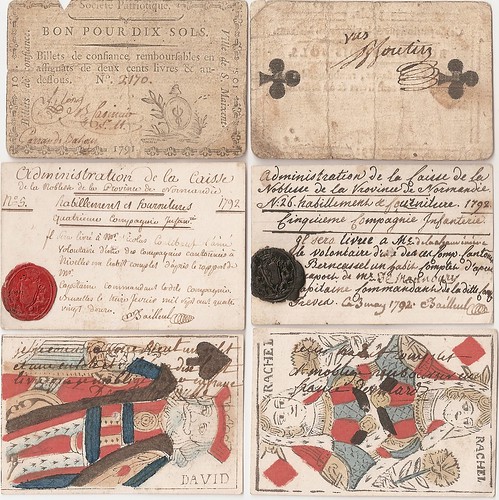
PREV ARTICLE
NEXT ARTICLE
FULL ISSUE
PREV FULL ISSUE
MORE ON PLAYING CARD MONEYAn E-Sylum reader submitted these notes on playing card money. Thanks!
-Editor
 I was happy to find the article about the Canadian collector who acquired what appear to be two IOUs or redeemable chits for bottles (?) of rum, created using playing cards, attributed to a Canadian merchant. I happen to have a large exhibit I've been showing at SoCal venues this year, which I plan to spring on the ANA when it convenes in Anaheim in 2016, entitled "Variations on a Theme of Playing Card Money." First, to attract the attention of US collectors, I provide background information on the extremely rare and valuable government-issued Canadian playing card money. I show a recent set of colorful commemorative coins, but only a photo of an actual example. (I don't own any but in my defense I cite auction prices in 4 and 5 figures.) However, following that intro are two halfway-decent (no tape) pieces of very rare playing card money issued by a French municipality (billets de confiance) during the Revolution. Those are followed by my large collection of playing card promissory notes filled with counter-writing not only signed and dated, but bearing intact wax seals from an expatriate French nobleman who was supplying the Monarchist resistance back home in Normandy with mercenary soldiers from Brussels. That section is followed by paper and porcelain notgeld and a coin which feature card games with local ties, to wit: Altenburg, Germany - Skat; and Switzerland - Jass; together with multiple decks of those cards. Finally, I show a deck of modern gold-foil playing cards that "reflect" 500 euro notes. I was embarrassed to include that cheesy tail end of the exhibit, but of course it attracted the most audience attention by far! I hope the judges at the ANA are more impressed by the historic repurposed hand-painted antiques, which got me going on this. In my scan of six playing cards, the top two should definitely qualify as "playing card money," since they are local government issues from 1791. The municipality was Saint-Maixent, in Deux-Sèvres département. The very first card is a king of clubs. The French specialized book about such things, Les billets de confiance de la Révolution française 1790 - 1793, Maurice Kolsky, 2004, estimates that there are three or fewer examples of each denomination of these pieces known (R5), but I doubt that is correct. The other four are fronts and backs of some of my promissory card/notes, issued from Brussels and signed and dated in 1792 by the marquis of Bailleul, Angerville-Bailleul, Haut-Normandie, to be conveyed by mercenaries into Normandy, where they were exchanged for military uniforms. I translated the text on both sides of one of the cards for my exhibit. To read the earlier E-Sylum article, see:
Wayne Homren, Editor The Numismatic Bibliomania Society is a non-profit organization promoting numismatic literature. See our web site at coinbooks.org. To submit items for publication in The E-Sylum, write to the Editor at this address: whomren@gmail.com To subscribe go to: https://my.binhost.com/lists/listinfo/esylum All Rights Reserved. NBS Home Page Contact the NBS webmaster 
|